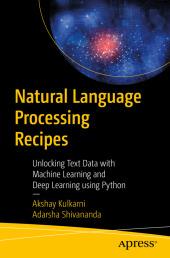 Neuerscheinungen 2019Stand: 2020-02-01 |
Schnellsuche
ISBN/Stichwort/Autor
|
Herderstraße 10
10625 Berlin
Tel.: 030 315 714 16
Fax 030 315 714 14
info@buchspektrum.de |

Akshay Kulkarni, Adarsha Shivananda
(Beteiligte)
Natural Language Processing Recipes
Unlocking Text Data with Machine Learning and Deep Learning using Python
1st ed. 2019. xxv, 234 S. 54 SW-Abb. 235 mm
Verlag/Jahr: SPRINGER, BERLIN; APRESS 2019
ISBN: 1-484-24266-1 (1484242661)
Neue ISBN: 978-1-484-24266-7 (9781484242667)
Preis und Lieferzeit: Bitte klicken
Implement natural language processing applications with Python using a problem-solution approach. This book has numerous coding exercises that will help you to quickly deploy natural language processing techniques, such as text classification, parts of speech identification, topic modeling, text summarization, text generation, entity extraction, and sentiment analysis.
Natural Language Processing Recipes starts by offering solutions for cleaning and preprocessing text data and ways to analyze it with advanced algorithms. You´ll see practical applications of the semantic as well as syntactic analysis of text, as well as complex natural language processing approaches that involve text normalization, advanced preprocessing, POS tagging, and sentiment analysis. You will also learn various applications of machine learning and deep learning in natural language processing.
By using the recipes in this book, you will have a toolbox of solutions to apply to your own projects in the real world, making your development time quicker and more efficient.
What You Will Learn
Apply NLP techniques using Python libraries such as NLTK, TextBlob, spaCy, Stanford CoreNLP, and many more
Implement the concepts of information retrieval, text summarization, sentiment analysis, and other advanced natural language processing techniques.
Identify machine learning and deep learning techniques for natural language processing and natural language generation problems
Who This Book Is For Data scientists who want to refresh and learn various concepts of natural language processing through coding exercises.
Chapter 1: Extracting the data
Chapter Goal: Understanding the potential data sources to build natural language processing applications for business benefits and ways to extract the data with examples
No of pages: 20
Sub - Topics:
1. Data extraction through API
2. Web scraping
3. Regular expressions
4. Handling strings
Chapter 2: Exploring and processing text data
Chapter Goal: Data is never clean. This chapter will give in depth knowledge about how to clean and process the text data. It also cover tokenizing and parsing.
No of pages: 15
Sub - Topics
1. Text preprocessing methods using python
1. Data cleaning
2. Lexicon normalization
3. Tokenization
4. Parsing and regular expressions
5. Exploratory data analysis
Chapter 3: Text to features
Chapter Goal: One of the important task with text data is to transform text data into machines or algorithms understandable form, by using different feature engineering methods
No of pages: 20
Sub - Topics
1. Feature engineering using python
o One hot encoding
o Count vectorizer
o TF-IDF
o Word2vec
o N grams
Chapter 4: Advanced natural language processing
Chapter Goal: A comprehensive understanding of key concepts, methodologies and implementation of natural language processing techniques.
No of pages: 40
Sub - Topics:
1. Text similarity
2. Information extraction - NER
3. Topic modeling
4. Machine learning for NLP -
a. Text classification
b. Sentiment Analysis
5. Deep learning for NLP-
a. Seq2seq,
b. Sequence prediction using LSTM and RNN
6. Summarizing text
Chapter 5: Industrial application with end to end implementation
Chapter Goal: Solving real time NLP applications with end to end implementation using python. Right from framing and understanding the business problem to deploying the model.
No of pages: 40
Sub - Topics:
1. Consumer complaint classification
2. Customer reviews sentiment prediction
3. Data stitching using text similarity and record linkage
4. Text summarization for subject notes
5. Document clustering
6. Architectural details of Chatbot and Search Engine along with Learning to rank
Chapter 6: Deep learning for NLP
Chapter Goal: Unlocking the power of deep learning on text data. Solving few real-time applications of deep learning in NLP.
No of pages: 40
Sub - Topics:
1. Fundamentals of deep learning
2. Information retrieval using word embedding´s
3. Text classification using deep learning approaches (CNN, RNN, LSTM, Bi-directional LSTM)
4. Natural language generation - prediction next word/ sequence of words using LSTM.
5. Text summarization using LSTM encoder and decoder.


